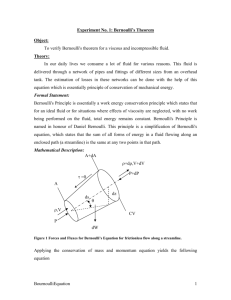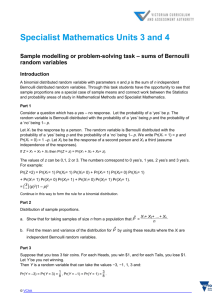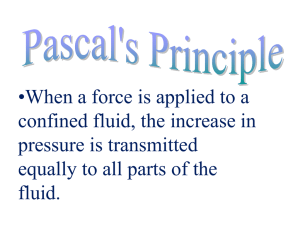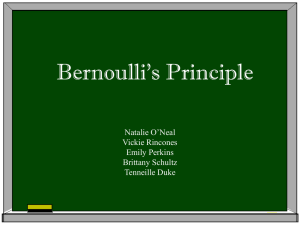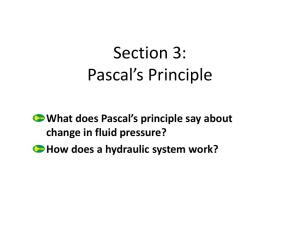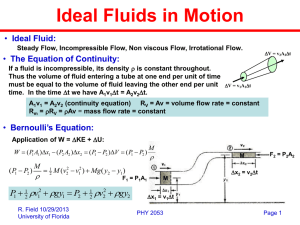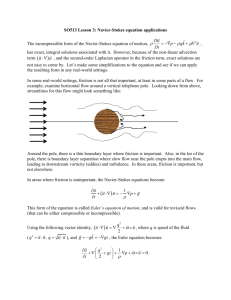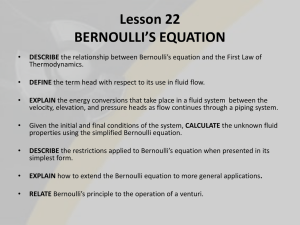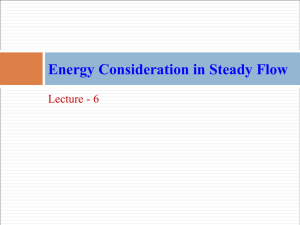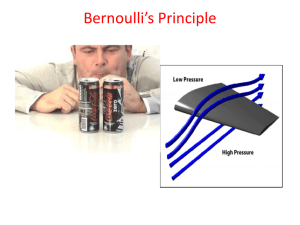Worked Out Examples
advertisement
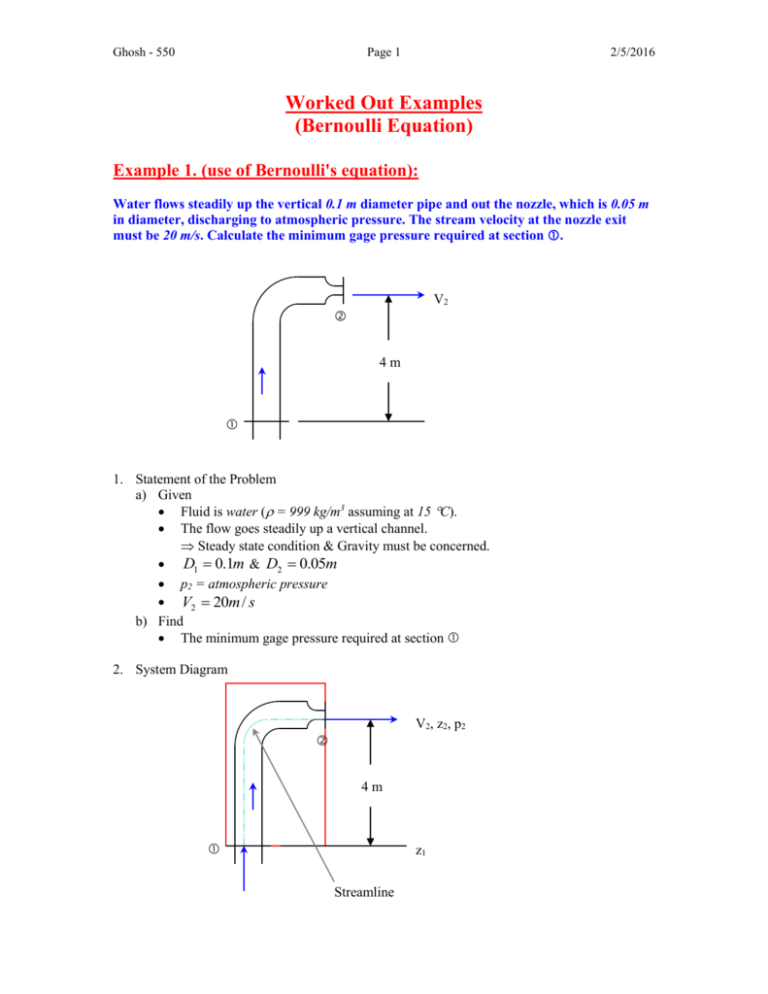
Ghosh - 550 Page 1 2/5/2016 Worked Out Examples (Bernoulli Equation) Example 1. (use of Bernoulli's equation): Water flows steadily up the vertical 0.1 m diameter pipe and out the nozzle, which is 0.05 m in diameter, discharging to atmospheric pressure. The stream velocity at the nozzle exit must be 20 m/s. Calculate the minimum gage pressure required at section . V2 4m 1. Statement of the Problem a) Given Fluid is water ( = 999 kg/m3 assuming at 15 C). The flow goes steadily up a vertical channel. Steady state condition & Gravity must be concerned. D1 0.1m & D2 0.05m p2 = atmospheric pressure V2 20m / s b) Find The minimum gage pressure required at section 2. System Diagram V2, z2, p2 4m z1 Streamline Ghosh - 550 Page 2 2/5/2016 3. Assumptions Steady state condition Incompressible fluid flow (working fluid, water, is usually assumed to be incompressible) Inviscid fluid flow 2 - D problem 4. Governing Equations Bernoulli's Equation: p V2 gz const. 2 Restrictions: V1, p1 (1) (2) (3) (4) Steady flow Incompressible flow Frictionless flow Flow along a streamline 0 t CV dV V dA … Integral version of mass conservation (to find V1 first.) CS Imagine a control volume (one possibility is shown on the diagram by the box sketched in red) such that control surface intersects with the inlet and the outlet areas. Now, for an incompressible fluid flow problem, the equation above 0 V dA CS 1 inlet () and 1 outlet () 0 V1 A1 V2 A2 5. Detailed Solution The Bernoulli's equation can be applied between any two points on a streamline provided that the other three restrictions are satisfied. The result is 2 p1 2 V p V 1 gz1 2 2 gz 2 2 2 where subscripts 1 and 2 represent any two points on a streamline that correspond to and in this particular problem. Now, the Bernoulli's equation can be written as: p1 p 2 1 2 2 V2 V1 g z 2 z1 2 Substituting 0 V1 A1 V2 A2 V1 p1 p 2 1 2 A V2 2 V2 2 A1 2 A2 V2 into the above equation, A1 g z 2 z1 Ghosh - 550 p1 p 2 Page 3 2/5/2016 2 1 2 A2 V2 1 g z 2 z1 2 A1 2 p1 p 2 1 2 D2 V2 1 2 2 D1 g z 2 z1 2 D2 2 A2 D2 4 2 A1 2 D1 D1 4 2 2 p1gage patm p2 gage patm 1 V2 2 1 D22 g z 2 z1 D1 2 Finally, p1gage p 2 gage 2 2 2 1 2 D2 V2 1 2 g z 2 z1 2 D1 p2gage is 0 kPa because p2 = atmospheric pressure. Thus, 1 0.05m 2 2 2 2 p1gage 0kPa 999kg / m 20m / s 1 9.81m / s 4m 0m 2 2 0.1m Therefore, the minimum gage pressure required at section , p1gage 226.5kPa 3 6. Critical Assessment Remember that four restrictions must be satisfied to use the Bernoulli's equation. Example 2. (Bernoulli's equation and Manometry) Water flows from a very large tank through a 2 in. diameter tube. The dark liquid in the manometer is mercury. Estimate the velocity in the pipe and the rate of discharge from the tank. 12 ft 2 in. i.d. Flow 2 ft 6 in. Mercury Ghosh - 550 Page 4 2/5/2016 1. Statement of the Problem a) Given All information is described in the figure above. b) Find Velocity in the pipe Rate of discharge from the tank 2. System Diagram , p1, V1, z1 Streamline 12 ft 2 in. i.d. , p2, V2, z2 A h1 = 2 ft Flow C B h2 = 6 in. = 0.5 ft Mercury 3. Assumptions Steady state condition Incompressible fluid flow (water, working fluid, is usually considered as incompressible) Inviscid fluid flow 2 - D problem 4. Governing Equations Bernoulli's Equation: p V2 gz const. 2 Restrictions: (5) Steady flow (6) Incompressible flow (7) Frictionless flow (8) Flow along a streamline 5. Detailed Solution Physical quantities: S .G. 13.55 (Specific gravity of mercury) mercury water 1.94slug / ft 3 at 59 F g 32.174 ft / s 2 Ghosh - 550 Page 5 2/5/2016 Pressure variation in any static fluid is described by the basic pressure-height relation dp g (This equation is from fluid statics.) dz Thus, dp g dz p p0 dp gdz p p0 g z 0 z p p0 gh z z0 Consider the portion of the figure A, B, and C as a U-tube manometer. Using this statics relationship (Pascal's Law), p A p B water gh1 p B pC mercury gh2 Adding the two equations gives p A pC mercury gh2 water gh1 Since pC p atm , p A p atm S .G. water gh2 water gh1 water g S .G. h2 h1 mercury 1.94slug / ft 32.174 ft / s 13.550.5 ft 2 ft 298.044lbf / ft 2 mercury p A p atm 3 2 This pressure pA is same as the pressure p2 because of the absence of pressure drop for inviscid fluid flow. Thus, p 2 298.044lbf / ft 2 p atm The Bernoulli's equation can be applied between any two points on a streamline provided that the other three restrictions are satisfied. The result is p1 2 2 V p V 1 gz1 2 2 gz 2 2 2 where subscripts 1 and 2 represent any two points on a streamline that correspond to and in this particular problem. Now, the Bernoulli's equation can be written as: p p2 1 2 2 V2 V1 1 g z1 z 2 2 p p2 2 2 V2 2 1 g z1 z 2 V1 Using an approximation V1 0 ft/s because Areservoir >> Apipe , and p1 = patm, p p2 2 2 V2 2 atm g z1 z 2 0 ft / s Ghosh - 550 Page 6 2/5/2016 p 298.044lbf / ft 2 p atm 2 V2 2 atm 32.174 ft / s 2 12 ft 0 ft 464.914 ft 2 / s 2 3 1.94slug / ft Finally, V2 21.56 ft / s Rate of discharge from the tank is: Q2 V2 A2 V2 4 D2 2 2 2 21.56 ft / s ft 0.470 ft 3 / s 4 12 6. Critical Assessment This problem illustrates how Bernoulli equation may be applied with manometry. Review fluid statics if you are not confident with how the Pascal's law was utilized to relate the pressures pA, pB and pC. Example 3. (Use of Bernoulli and Rotational Flows): Consider the flow represented by the stream function = Ax2y, where A is a dimensional constant equal to 2.5 ft-1s-1. The density is 2.45 slug/ft3. Is the flow rotational? Can the pressure difference between points (x,y) = (1,4) and (2,1) be evaluated? If so, calculate it, and if not, explain why. 1. Statement of the Problem a) Given Stream function = Ax2y, where A = 2.5 ft-1s-1 = 2.45 slug/ft3 p1(1,4) and p2(2,1) b) Find Whether the flow is rotational or irrotational. Pressure difference between points (x,y) = (1,4) and (2,1) if it can be evaluated. If not, explain why. 2. System Diagram It is not necessary for this problem. 3. Assumptions Steady state condition Incompressible fluid flow. Frictionless fluid flow 2 - D problem 4. Governing Equations Ghosh - 550 Page 7 2/5/2016 & v x y w v u w v u Vorticity: 2 V i j k z x y z x y p V2 Bernoulli's Equation: gz const. 2 Stream function (incompressible fluid flow version) definition: u Restrictions: (9) Steady flow (10) Incompressible flow (11) Frictionless flow (12) Flow along a streamline 5. Detailed Solution Velocity components can be obtained through the given stream function = Ax2y using the stream function definition: Ax 2 y Ax 2 y y v Ax 2 y 2 Axy x x u Since this is 2 - D (xy plane) problem, check z for rotationality of the flow field. 1 v u 1 z 2 Axy Ax 2 2 Ay 0 Ay 0 2 x y 2 x y 2 1 There is rotation in the flow field. You may wonder that there is no friction (no viscosity) but why the flow is rotational. Imagine that the fluid flow is rotated initially and keep rotating forever because of the absence of viscosity. Because the flow is rotational, Bernoulli's equation cannot be applied between any two points in the flow. The only way to apply Bernoulli's equation in this case is that two points must be on the same streamline. This can be verified by: Point 1 at (x,y) = (1,4): 1 = A(1)2(4) = 4A Point 2 at (x,y) = (2,1): 2 = A(2)2(1) = 4A 1 =2 Two points are on the same streamline. Bernoulli's equation can be applied between these two points. p1 V1 p V gz1 2 2 gz 2 2 2 Ghosh - 550 Page 8 Ignoring the elevation difference, p2 p1 2/5/2016 1 1 V12 V22 u12 v12 u 22 v22 2 2 u1 = Ax12 = A(1)2 = A v1 = -2Ax1y1 = -2A(1)(4) = -8A u2 = Ax22 = A(2)2 = 4A v2 = -2Ax2y2 = -2A(2)(1) = -4A Substituting these velocities into Bernoulli's equation, 1 1 33 A2 8 A2 4 A2 4 A2 33 A2 A2 2 2 2 33 2 33 p2 p1 A 2.452.52 252.66 lbf/ft2 2 2 p2 p1 6. Critical Assessment Make sure four restrictions are all satisfied before using Bernoulli's equation. Continue
